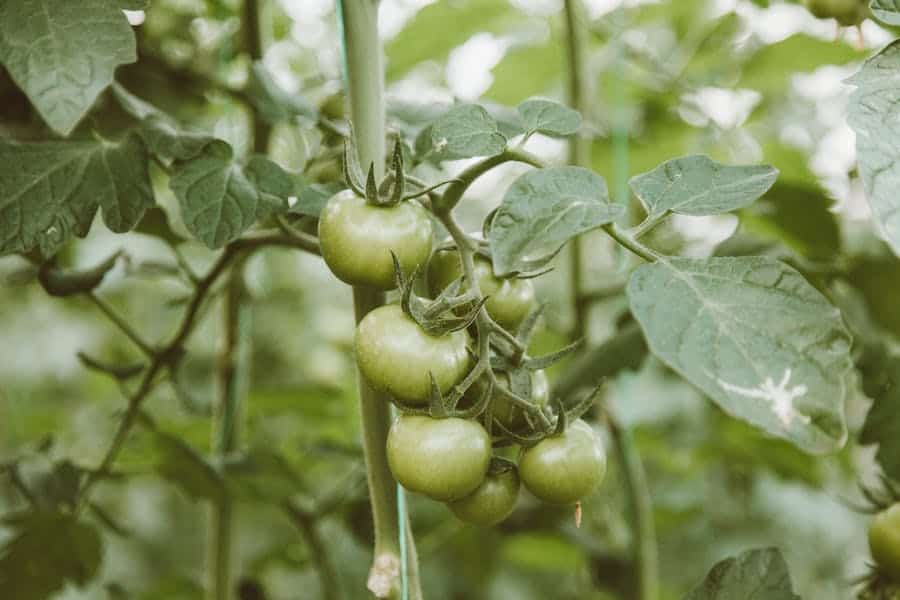Tomatoes, with their juicy red allure, are a garden favorite and a staple in many dishes worldwide. However, even these popular fruits, known for their robust growth and plentiful yields, can sometimes face nutritional challenges. One of the most common yet overlooked issues for tomatoes is calcium deficiency. While calcium might be more commonly associated with strong bones in humans, in the world of tomatoes, it plays a pivotal role in ensuring healthy cell development and fruit set. A deficiency can lead to a dreaded condition called blossom end rot, where the end of the tomato fruit turns black and gets sunken. Thus, ensuring that your tomato plants receive an adequate calcium supply isn’t just a matter of good gardening practice; it’s essential for a successful harvest. But how do you add calcium to your tomato plants, and what are the best methods to ensure its efficient uptake? Whether you’re a seasoned gardener or just starting out, this guide will provide comprehensive insights into recognizing, preventing, and treating calcium deficiencies in tomato plants, ensuring your efforts in the garden translate to a healthy, bountiful harvest.
How To Add Calcium To Tomato Plants?
Tomatoes, revered for their delicious taste and versatility in the kitchen, are among the most grown fruits in gardens worldwide. However, like any plant, tomatoes have their nutritional needs. One such vital nutrient is calcium. Ensuring a steady supply of calcium not only aids in the development of strong cell walls but also wards off the ominous blossom end rot—a condition where the fruit’s end turns black and sunken.
The Eggshell Method:
One of the most popular home remedies is using eggshells. Rich in calcium, they can be a garden’s best friend. Start by saving and rinsing out your used eggshells. Dry them out and then crush them finely. You can use a mortar and pestle or a blender to achieve a powdery consistency. Once prepared, simply sprinkle the eggshell powder around the base of your tomato plants and gently mix it into the soil. As they degrade, they’ll release calcium into the ground, providing nourishment to your plants.
Bone Meal As A Source:
Bone meal is another natural source of calcium. It’s a byproduct of the meat industry and can be procured easily from garden centers. To use bone meal, follow the package instructions, generally mixing it into the soil at planting time or adding it as a top dressing. It has the added advantage of being slow-releasing, ensuring that your tomatoes get a steady calcium supply over time.
Crushed Oyster Shells And Garden Lime:
Often used to adjust the pH of the soil, crushed oyster shells and garden lime also offer calcium to plants. When preparing your garden bed for planting, spread either of these generously over the soil and then work it in. Oyster shells, being coarser, take longer to break down and thus provide a prolonged source of calcium. Lime, on the other hand, gets to work quickly, providing almost instant benefits.
Calcium-Infused Water:
If you’re looking for a quicker fix, especially for plants already showing signs of deficiency, then calcium-infused water is your best bet. Tablets like Tums, made primarily of calcium, can be dissolved in water. This solution can then be directly watered onto the plants, offering a quick dose of the much-needed mineral. Another trick involves boiling eggshells in water, letting it steep overnight, and using this water for your plants.
Commercial Calcium Supplements:
For those who prefer a more straightforward approach or are dealing with a severe deficiency, commercial calcium supplements might be the answer. Available in various forms, like calcium nitrate or calcium chloride, these can be mixed with water and applied directly to the plants. They act fast and are especially useful if you’re seeing a lot of your tomatoes affected by blossom end rot. Remember always to follow the manufacturer’s instructions to prevent over-fertilization.
Powdered Milk—A Surprising Source:
While not the most conventional method, powdered milk can also be used as a calcium source. Simply sprinkle it around the base of your tomato plants and water it in. As the milk dissolves and seeps into the soil, it releases calcium.
Maintain A Stable PH Level:
While adding calcium sources, it’s equally vital to ensure that your soil’s pH is conducive to its absorption. Tomatoes thrive in slightly acidic to neutral pH levels (6.2 to 6.8). At this level, calcium absorption is optimized. Regularly test your soil’s pH and adjust accordingly using lime to raise it or sulfur to lower it.
How Do I Know If My Tomatoes Need Calcium?
Tomatoes, while fairly easy to grow, come with their own set of challenges. One of these challenges revolves around their nutritional needs, specifically the requirement for calcium. Ensuring that your tomato plants have adequate calcium is crucial for their overall health and fruit development. But how can you tell if your tomatoes are crying out for this vital mineral? Let’s delve into the tell-tale signs.
- Blossom End Rot: This is the most definitive sign of calcium deficiency in tomatoes. Blossom end rot manifests as a dark, sunken, and water-soaked spot at the blossom end (the bottom) of the fruit. This spot enlarges and becomes leathery or blackened as the fruit matures. It makes the fruit unattractive and reduces its overall quality. While this condition is primarily linked to inadequate calcium uptake by the plant, it can also be aggravated by irregular watering since water facilitates calcium transport in plants.
- Leaf Curl: Another less direct sign of calcium deficiency is the curling of tomato leaves. Though leaf curl can be attributed to various factors, including pests, diseases, and environmental stress, a sustained curl without any visible pests might hint at a nutritional imbalance, including calcium deficiency.
- Stunted Growth: Calcium plays a crucial role in cell division and growth. Plants deficient in calcium may display stunted growth, with the new leaves and roots being the first to get affected. The roots may become short and thickened, and there might be a noticeable delay in the plant’s overall development.
- Poor Fruit Set: Calcium is essential for root and leaf development, which in turn affects the fruit set. If your tomato plants are producing fewer fruits than expected or if the fruits drop prematurely, it could be an indirect sign of calcium deficiency.
- Leaf Tip Burn: While often associated with other issues, the browning or “burning” of leaf tips can sometimes be a manifestation of calcium deficiency. Calcium helps in forming the cell wall structure; without it, the cell edges can break down, leading to this burnt appearance.
Additional Tips For A Healthy Tomato Harvest
Tomatoes, often dubbed the ‘stars of the summer garden,’ require more than just sunlight and water to flourish. As with all plants, they thrive best when provided with a balanced environment. Beyond calcium, there are several other considerations that can ensure a rich and healthy harvest. Here are some vital tips:
- Balancing Other Nutrients: Just as our bodies require a range of vitamins and minerals, tomato plants benefit from a balanced soil rich in various nutrients. Magnesium, for example, can be added using Epsom salt, which aids in fruit ripening. Potassium, another essential, promotes strong roots and enhanced flavor. Remember, overloading on one nutrient can inhibit the uptake of others, so always aim for balance.
- Right Tomato Varieties: Every region has specific tomato varieties that are best suited to its conditions. Whether it’s the sun-loving ‘Brandywine’ or the short-season ‘Early Girl’, choosing the right variety can make a huge difference in yield and disease resistance.
- Maintain Proper Soil Moisture: Tomatoes hate waterlogged roots but also dislike being too dry. A consistent watering routine, preferably in the early morning, helps prevent diseases and stress. Additionally, mulching around the base can retain moisture and regulate soil temperature.
- Staking And Pruning: As tomato plants grow, they can become heavy and unwieldy. Staking or caging them supports their growth upwards and ensures better air circulation, reducing the risk of fungal diseases. Regularly pruning the non-fruiting branches can also divert energy to fruit production
- Companion Planting: Planting tomatoes alongside beneficial plants like basil or marigolds can deter pests naturally. Such companions not only enhance growth but also add a layer of protection against common pests.
- Regular Health Checks: Just as a doctor might advise regular check-ups, regularly inspecting your tomato plants for signs of diseases or pests will enable early intervention and increase the chances of a healthy yield.
Conclusion
Ensuring a bountiful and healthy tomato harvest is an intricate dance of knowledge, care, and vigilance. Among the essential nutrients that these vibrant fruits require, calcium stands out for its pivotal role in preventing the all-too-common menace of blossom end rot. By understanding its significance and efficiently adding it to our tomato plants, we bolster their health, ensuring that they can produce at their best. But beyond calcium, a tomato’s needs span a spectrum of nutrients, attention to soil pH, and a watchful eye for potential pests or diseases. As with many endeavors in gardening, the key lies not just in addressing immediate issues but in embracing a holistic approach. By intertwining knowledge about calcium supplementation with broader gardening practices, we lay the foundation for a tomato harvest that is both abundant and rewarding.
FAQ’s
Does Epsom Salt Have Calcium For Tomato Plants?
No, Epsom salt does not contain calcium. Epsom salt is primarily magnesium sulfate. It provides magnesium, which is essential for seed germination and photosynthesis, and sulfur, which is vital for amino acid formation in plants.
Can I Sprinkle Epsom Salt Around My Tomatoes?
Yes, you can sprinkle Epsom salt around your tomatoes. Epsom salt can be beneficial for tomatoes that are magnesium deficient. A common method is to sprinkle a tablespoon of Epsom salt around the base of the plant and then water it in. However, it’s crucial not to overdo it, as too much magnesium can compete with the plant’s uptake of calcium.
What Is The Best Source Of Calcium For Plants?
The best source of calcium for plants often depends on specific soil conditions and needs. Some common sources include gypsum (calcium sulfate), which is frequently used to address calcium needs without affecting soil pH. Lime (calcium carbonate) is another option that adds calcium and raises soil pH, making it more alkaline, especially beneficial for gardens with acidic soil. Bone meal is a natural source of calcium, although it releases its nutrients slowly. Crushed eggshells are another natural method, but they also decompose over time. For those seeking a fast-acting solution, calcium nitrate provides both calcium and nitrogen. It’s crucial to conduct a soil test before adding any amendments to understand what your soil requires and add the appropriate source.




















Leave a Reply